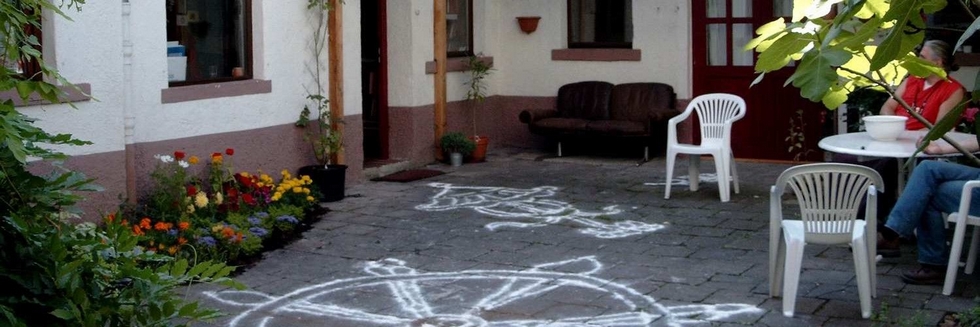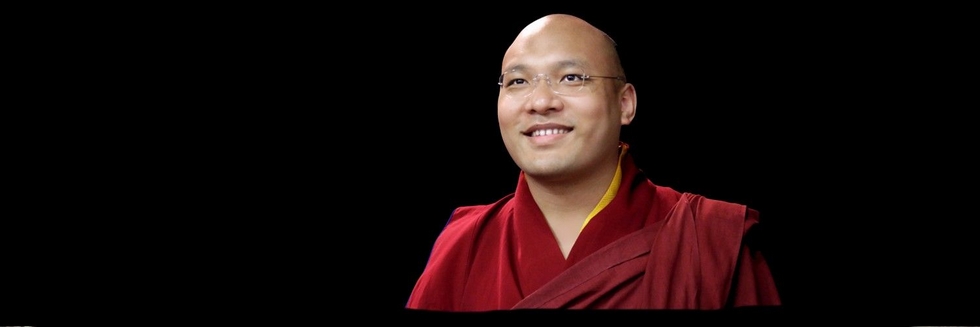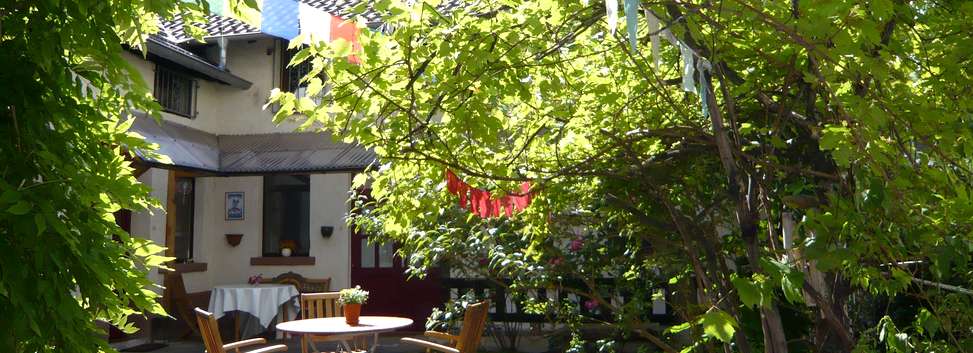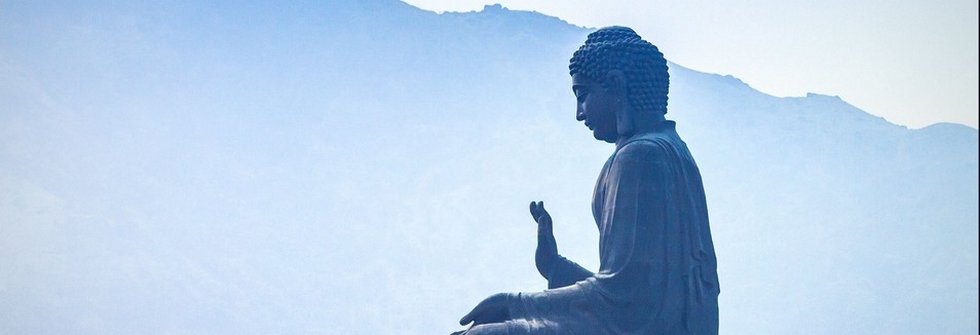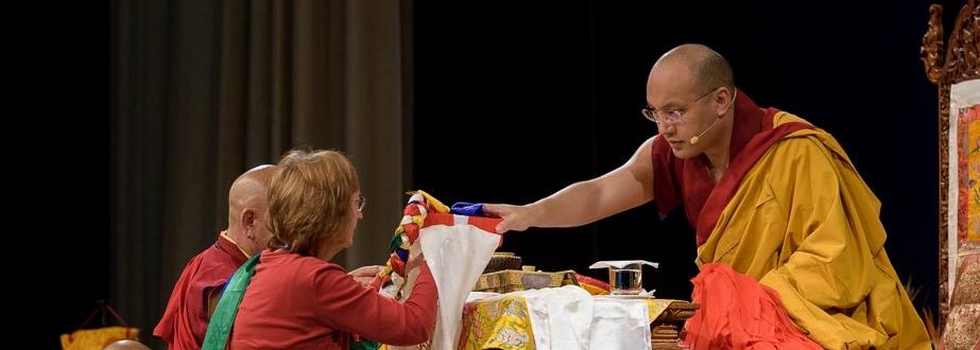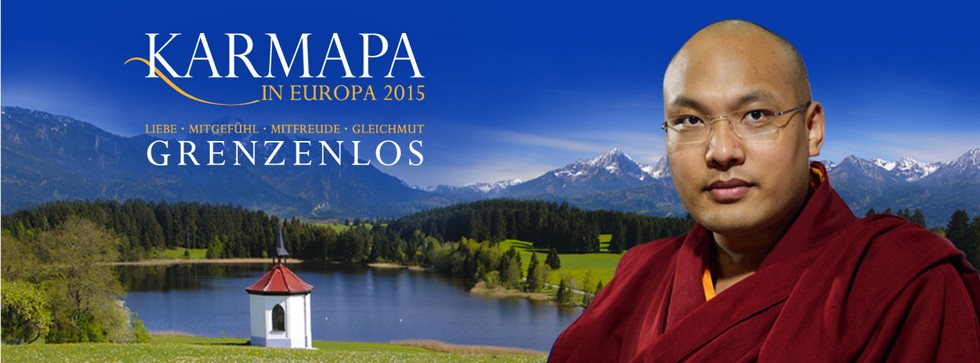Venerable Chöje Lama Namse Rinpoche
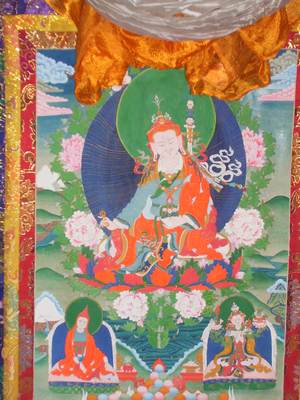
Guru Rinpoche - A Short Introduction to His Life & Activities
Presented at Karma Chang Chub Choephel Ling, Heidelberg, in 2007.
This transcript is dedicated
in memory of our precious Root Guru, His Eminence the IIIrd Jamgon Kongtrul,
Karma Lodrö Chökyi Senge (1954-1992) &
to the long life of
His Eminence the IVth Jamgon Kongtrul, Lodrö Chökyi Nyima &
Venerable Chöje Lama Namse Rinpoche.
May their enlightened activities flourish & benefit countless sentient beings.
Introduction
May I greet you kindly and welcome you. Let us recite "The Dorje Chang Lineage Prayer" together before I speak about the life-story of Guru Rinpoche. From among his many names, Guru Rinpoche is best known as Guru Padmasambhava. I will refer to him as Guru Rinpoche during this seminar.
There are many hagiographies of Guru Rinpoche, i.e., biographies of how he attained liberation. Some hagiographies, rnam-tar in Tibetan, are very long, consisting of many volumes and each having hundreds of pages. Others are very short, consisting of a few pages and only using keywords that point to major events in his life. Many of them even seem to make contradictory statements. It's important to know that Guru Rinpoche was a highly realized master whose far-reaching activities continue in modern times, which is the reason it is said that he is immortal. He was, i.e., he is, so highly realized that he appeared to living beings in a great number of ways. Therefore, it isn't surprising that there are two versions about his birth that seem to contradict each other.
The most popular version of Guru Rinpoche's birth is based on the recorded words of Lord Buddha who prophesied that Guru Rinpoche would be the Second Buddha of our times, that he would be miraculously born on the bud of a lotus flower and not from the womb of a woman. Other hagiographies state that he was born to a physical mother. There is a purpose to these two versions. They are skilful means that serve the needs and capabilities of the great variety of living beings' propensities. People who reject the one version can resort to the other and thereby they can gain trust and have confidence in him. Even though there seem to be these discrepancies about his birth, the reports about the central events of his life are the same in all hagiographies, no matter how long or how short they are.
Lord Buddha prophesied in Sutra the way Guru Rinpoche would take birth and clearly spoke of his countless activities for the benefit of all sentient beings. We can rely on the words of the Buddha and know that Guru Rinpoche is the manifestation of all Buddha activities that appear in the world for the welfare of everyone.
Before looking at the life-story of Guru Rinpoche, allow me to say that having a text on his life in one's home is already an extraordinary blessing. Lord Buddha and many later realized masters said that the immense blessing and profound inspiration one receives by having such a text in one's home are due to the fact that Guru Rinpoche continues being the manifestation of the loving compassion, kindness, and wisdom that the Buddhas of all times have for all living beings. Merely the presence of a text on his life in one's home dispels many obstacles.
From among the longer and shorter versions of the life-stories of Guru Rinpoche, there are three main forms. The long versions consist of many volumes, are very detailed, and are written in poetic verses. The middle-length versions are more factual and therefore more suitable for study. The very short versions consist of keywords and are easy to carry. Since every version deals with the same subject, all of them equally grant Guru Rinpoche's full inspiration and blessings. Merely having a version of his life-story in one's home, or reading it alone or together with one's family members or friends, or just thinking about a few events in his life dispels one's emotional disturbances, mind poisons, mental obscurations, etc. that one has accumulated since time that is without a beginning. It is logical that the blessings one receives by reading and studying the life-story of Guru Rinpoche are even more beneficial than owning a text. It is said that due to having been inspired by his life-story and due to having practiced the profound methods of Vajrayana that he and his disciples taught, for hundreds of years many followers generated and developed great devotion in the Dharma and in the teachers, practiced the path, and thus attained perfect enlightenment.
It is said that Guru Rinpoche was and is ever-present as the Dharmakaya aspect of enlightenment. Average people like us, who haven't even come near the attainment of enlightenment, cannot perceive the all-pervading Dharmakaya that all Enlightened Beings manifest. It is also said that Guru Rinpoche was and is ever-present as the Sambhogakaya aspect of enlightenment. But only practitioners who have achieved very advanced levels of realization can perceive the all-embracing Sambhogakaya manifestation of Enlightened Beings. Average individuals can only perceive a visible and tangible Nirmanakaya aspect of enlightenment that manifests in the form of a human being to benefit people like us. All life-stories of Guru Rinpoche - his autobiography, his disciples' recorded accounts, and biographies that later disciples wrote - speak about the events and activities of his Nirmanakaya manifestation.
Guru Rinpoche's Birth & Childhood
The most widely spread accounts of Guru Rinpoche tell us that he was born in a wondrous way in the Kingdom of Oddiyana, O-rgyän in Tibetan. One can say that the ruler of Oddiyana, King Indrabodhi, was like an enlightened king whose only concern was the well-being of his subjects. He wasn't at all arrogant or aggressive. He ruled peacefully, was in harmony with neighbouring countries, and was always very generous towards everyone in his land. He only had one problem: none of his consorts gave birth to an heir. Since King Indrabodhi was getting older, this worried him greatly. He called all his ministers, spiritual teachers, and astrologers together and asked for their advice. They told him that he would accumulate the necessary merit to have a son if he invited beggars from all the lands to his kingdom, gave them shelter, clothes, and food for a longer period of time, and engaged in other welfare activities. The king understood that this was really good advice and, during special times in the year, he fed, clothed, and offered living quarters to thousands of beggars and destitute people who came to his kingdom from near and far. He practiced in this way for many years, until the treasury of his kingdom was almost empty and the inhabitants of Oddiyana were impoverished. Yet, no son was born to him. He became even more worried about an heir than he had been before.
King Indrabodhi again summoned his ministers, spiritual teachers, and astrologers for a meeting and told them, "For many years I did as you said. I made offerings to the Three Jewels and helped an immense number of people in need. Now the treasury is almost empty and no heir has been born to me. Please tell me what to do, because I cannot continue in this way much longer." They discussed the situation and many of those who attended the meeting made rather stark suggestions. Some of them made proposals on how to boost the economy; others even suggested invading and robbing neighbouring countries of their wealth. Since Indrabodhi was a Dharma King who adhered to the teachings of the Buddha, he rejected such ignoble thoughts. An elderly Brahmin and priest in the court stepped forward and said to the king, "Last night I dreamed about an island far away in the ocean that is covered with jewels. One only has to sail to that island, fill one's cases and caskets with the precious stones, and sail home again. This would restore the kingdom's treasury with even more riches than before." The king liked the idea. He and his ministers boarded the ship that was anchored in the harbour, set out to sea, reached Jewel Island, filled all cases and caskets that the group had taken along with the treasures that were lying around, and sailed home, richly laden. But, while on the way home, the king wasn't really happy that his kingdom would flourish again. He knew that political crises and battles among the ministers would arise if he died without leaving an heir to the throne. He was very worried that peace in his kingdom would be disrupted if no heir was born to him.
It so happened that the group decided to take another road on their way back to the palace in the capital of Oddiyana after their ship anchored. They took a road that led through valleys and across mountain passes and at one point saw a lake that nobody had ever heard of or knew about. It was in an area more beautiful than can be imagined - birds twittered in the trees, rainbows appeared everywhere in the sky, there were many waterfalls, etc. When they reached its shore, they were even more surprised at the beauty of the lake that nobody had ever heard of. They saw a single huge lotus in full bloom right in the middle of the lake. From where they stood, they saw what appeared to be an eight-year-old boy seated on the lotus. The child was surrounded by all kinds of goddesses and Dakinis who were making a great variety of offerings and were singing songs of praise to him. The king and the courtiers who witnessed this marvel were completely astonished and stunned.
It is recorded in a number of Sutras that the Buddha predicted that shortly after he passed into Parinirvana a Second Buddha would appear and have the name Padmakara, `Lotus-born.' Furthermore, the Buddha said that the Second Buddha would spread the sacred Dharma and, particularly, he would teach the profound skilful methods of Secret Mantrayana or Vajrayana. He was none other than the child that King Indrabodhi and his courtiers saw seated on the lotus flower in the middle of the lake. The lake has come to be known as Lake Danakosha. The child would later become known as Guru Padmasambhava, the Sanskrit name for `Lotus-born Teacher and Master.' In Tibet he is known as Guru mThso-skyes-rdo-rje.
It is recorded that preceding the event just described, the Buddhas residing in the Pure Realms consulted each other on how to best help beings living in the world mature spiritually by means of the profound, skilful, efficient, and quick methods of Vajrayana. Buddha Amitabha said, "I will send my heart-emanation into the world and he will become known as the Lotus-born Master. He will impart the teachings of the Secret Mantrayana to beings who are ready to receive them. He will also secure the teachings so that they remain in the world for the benefit of future generations and can spread further after he has parted." It is said that Buddha Amitabha sent a brilliant beam of light from his heart and had it touch the bud of the lotus flower on Lake Danakosha. In that moment, the One who would mainly become known as Guru Padmasambhava or Guru Rinpoche took birth, seated on the lotus flower that was touched by the radiant light of Buddha Amitabha. At this time, Guru Rinpoche is referred to as Padmakara, `Lotus-born,' Päd-ma-`byung-gnäs in Tibetan.
When he saw the child while standing at the lake's shore, King Indrabodhi was filled with so much joy and devotion that he fell on his knees and tears spontaneously flowed from his eyes. He now understood the dream he had the night before setting out on the road to return to his palace from Jewel Island. The king had dreamed that he was asleep on a bed that was set in a huge pavilion that was open on all sides and that was filled with streaming light. He dreamed that the Enlightened Beings of all times appeared in the sky and held council on sending a mutual emanation into the world. They manifested in the form of a 5-spoked vajra. He felt extremely happy while envisioning light radiating from the vajra's center and entering his heart. When he woke up the next morning and remembered his dream, he was certain that all his worries would end soon. He didn't tell anybody about his dream, though. He knew that it was auspicious, but didn't know what to really make of it. All doubts he had about the meaning of his dream vanished and he knew what he would do the moment he saw what appeared to be an eight-year-old boy seated on the lotus flower. He knew that he would invite the boy to his palace, raise him, and give him a good education. He offered all the riches he had gathered on Jewel Island to the boy and asked him to accept his invitation. The boy replied, "Yes, Great Dharma King. I accept your offer and will gladly come with you." In the next moment, the boy was standing on the shore of the lake, then took seat next to the king in the richly adorned palanquin, and was brought to the palace. All worries that King Indrabodhi had about an heir to his throne were finally over.
The king and his closest ministers asked Guru Rinpoche, "Where do you come from? Who is your father? Who is your mother? How is your family? What is the name of your clan? Tell us, what do you believe in and what do you practice?" He answered, "I come from nowhere. I have no father. I have no mother. I have no family and don't belong to a clan. I was born from the syllable HRIH that emanated from the heart of Buddha Amitabha. I have come into the world to help living beings, to show them the way, and to open their eyes."
In a festive procession that was led by the king and accompanied by the royal courtiers, Guru Rinpoche entered the capital and was enthroned as the crown prince of the Kingdom of Oddiyana. It was obvious to everyone that he was exceptional and they were certain that he would do many good things. As of this time, he is called Padmaraja, `Lotus King,' Päd-ma-rgyäl-po in Tibetan.
During the enthronement ceremony he told the king and the assembly, "All these valuable substances, the silk drapes and cushions studded with jewels, and the costly throne you have arranged do not flatter me. I am not of this world and therefore nothing of this world does justice to me." While all those who were assembled heard this and became bewildered, Guru Rinpoche snapped his fingers and precious objects, more beautiful than the ones placed before him and more elaborate than anything anyone had ever seen, appeared. Everyone who witnessed this momentous event experienced deep devotion for him and, having seen that he could perform such wonders at the age of eight, they thought that many more great things would occur in the future.
For a few years, Guru Rinpoche enjoyed the education befitting a prince. The king and his closest advisors, priests, and famous scholars taught him the various arts and sciences of the times. He led the stately life of a prince, was always surrounded by servants who fulfilled every wish he had, and could call everything in the magnificent palace his own. A few beautiful young girls had already been chosen to become his wives when he came of age and to later be the queens at his side.
After a few years had passed in this way, Buddha Vajrasattva appeared to Guru Rinpoche and told him, "Great obstacles for your future Dharma practice and activities, the purpose of your life in Jambudvipa, will arise if you continue living in this way." Guru Rinpoche understood the significance of these words and then and there resolved to turn his back on the convenient but superfluous life he was enjoying. He contemplated ways to get out of the situation of being a prince and of becoming a worldly ruler after the king's death.
Once again the king faced financial difficulties and, aware of the adopted prince's wondrous abilities, asked him, "What should we do to restore the treasury and to secure the needs of the people?" Guru Rinpoche replied, "I own a Wish-fulfilling Jewel. I will give it to you. All your wishes will come true if you formulate your wishes clearly and pray to it with one-pointed devotion." He gave the king the Wish-fulfilling Jewel. The king wrapped it in a precious silk cloth and placed it on a shrine that he had craftsmen make especially for it. He placed many offerings in front of the Wish-fulfilling Jewel and for many days and nights fervently prayed with one-pointed devotion that the treasury be restored to its previous wealth for the benefit of everyone. He prayed that none of his subjects suffer from hunger, cold, or heat and that everyone experience happiness and well-being. Due to his pure motivation, his wishes came true. The treasury of the kingdom overflowed with gold, silver, and jewels, the weather was perfect for the crops to grow abundantly, the crops were harvested on time, it was never too hot or too cold, and all inhabitants of Oddiyana were happy and at ease.
Guru Rinpoche realized that the time had come to begin cultivating his activities for the greater benefit of all living beings, rather than just working for the welfare of individuals living in Oddiyana by becoming the king. He left the palace and fled into the forests and mountains nearby. He meditated diligently for many months, realized the futility of worldly concerns, and resolved to live up to the purpose of his life, which was to teach living beings in accordance with their capabilities the Dharma that leads to perfect Buddhahood. The ministers, who were less realized and not convinced of such goals, found Guru Rinpoche in the woods and told him, "Our king believed in you and there is no other heir to the throne than you. Therefore, whether you like it or not, you have to return to the palace with us and live up to your obligations." Guru Rinpoche saw that he had to obey and returned to the palace. Upon his arrival, he immediately started teaching the Dharma and many of his disciples renounced worldly ways, practiced the instructions diligently, and attained perfect Buddhahood.
After a few years had passed, Guru Rinpoche left the palace disguised as a wandering ascetic and walked to India. I cannot go into the details here because of the time at our disposal during this seminar; you can read about this in the biographies that have been translated. So, this concludes the short introduction of the biography I am referring to during this seminar, which introduces students to Guru Rinpoche's appearance in the world and to his future activities.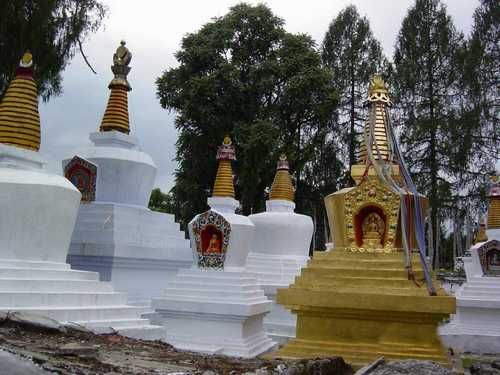
(Stupas at Tashiding Monastery in Sikkim. It is said that Guru Rinpoche shot an arrow into the air to select the place where he would meditate. The place where the arrow landed eventually became the site of Tashiding Monastery.)
Guru Rinpoche's Teachers in India
Guru Rinpoche met five great masters when he arrived in India. Having received the transmissions and instructions from them, he practiced and perfected them in the solitude of forests, jungles, and mountains. He became known far and wide by many names and everyone knew that he was an extraordinary master who would benefit beings immensely. At this time, he came to be known as Guru Shakyasimha, `Lion of the Shakyas,' Shakya Seng-ge in Tibetan, and is usually depicted on paintings looking similar to Buddha Shakyamuni.
Guru Rinpoche heard, reflected, and meditated the instructions and empowerments that he received from the five great Indian masters. In strict solitude, he perfected the many transmissions that Mahasiddha Prabhahasti had first imparted to him. Secondly, Guru Rinpoche studied with Mahasiddha Prahevajra, known as Lobpon Garab Dorje in Tibet; he was the first human teacher of Maha-Ati, the `Great Perfection' that is Dzogchen. Guru Rinpoche received the heart instructions of Dzogchen from him and, as before, practiced and perfected the teachings in strict solitude. Thirdly, Guru Rinpoche received the transmission of the "Guhyagarbha Tantra - The Tantra of the Secret Quintessence" from Master Buddhaguhya. It is a central Tantra of Vajrayana that Guru Rinpoche later brought to Tibet. As before, he practiced and perfected these teachings in solitary retreat. The fourth master who instructed Guru Rinpoche was Mahasiddha Shri Singha who imparted the "Chemchog Heruka Tantra" to him. Again, he meditated and perfected these teachings in solitude. Fifth, Mahasiddha Manjushrimitra imparted the empowerment and practice instructions of the "Yamantaka Tantra" to Guru Rinpoche, which he also practiced and perfected in retreat.
Furthermore, Mahasiddha Nagarjuna, not to be mistaken with Acharya Nagarjuna who founded the Middle-Way, imparted all transmissions related to the Lotus Family to Guru Rinpoche. Shri Hungkara transmitted the entire cycle of meditation practices and teachings on eight specific meditation deities to him. The eight, of which he had already received a few earlier, included the wrathful meditation deities Yamdrak, Vajrakilaya, Mamo Botong, and others. They all look similar, are winged, have 3 heads and 6 arms, and carry weapons. Shri Vimalamitra, not the master who later came to Tibet and had the same name, gave him the transmission and deep meditation instructions of a deity similar to Amrita Kundali. Shri Dhana Sankrita gave him the empowerments, oral reading transmissions, and practice instructions of Vajrakilaya and the "Kilabitutara Tantra," which has been lost but is the basis of all teachings of Vajrakilaya. Shri Shantigarbha transmitted the instructions associated with the wrathful mother goddesses to him. Guru Rinpoche received from many other masters transmissions and instructions on the three great cycles of Vinaya, Sutra, Abhidharma, as well as many others. Following, he went into solitary retreat to deepen and intensify his realizations.
This concludes the second chapter that lists the empowerments and instructions that Guru Rinpoche received from various masters in India and that he studied, practiced, and perfected under the guidance of great teachers.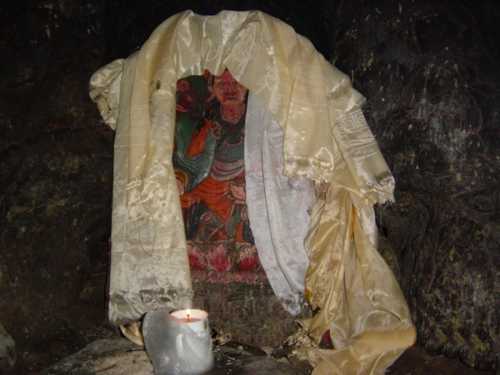
(Guru Rinpoche's cave in Sikkim)
Guru Rinpoche Received Prophecies & Manifested the Efficacy of the Dharma
Guru Rinpoche went to the eight great charnel grounds in India to meditate for a longer period of time and on those occasions was crowned with the reward of seeing the deities face-to-face. Each deity made prophecies and told him how to spread the respective teachings, which teachings were appropriate for which disciples, etc. Their instructions are in the text entitled, "The Eight Transmitted Precepts," which also includes the respective oral transmission of the specific deity, the corresponding rituals, and practice instructions that lead to liberation. It is the basis of all deity practices in the Nyingma Tradition.
Having practiced and perfected for his own benefit all instructions he had received, the time had come for Guru Rinpoche to manifest his realizations for the benefit of all living beings, which was his purpose to appear in the world. To do this, great masters first demonstrate their abilities to others by engaging in disputations to defeat opponents or by performing wondrous activities to gain disciples' trust and devotion. For this reason, Guru Rinpoche went to Bodhgaya and debated with 500 scholars from other schools of thought. Of course, he won all disputes. It is reported that Guru Rinpoche was active in a great variety of ways in different places in India for 500 years. In accordance with their abilities and in order to help them renounce futile concerns and follow the path of Dharma, he either gave individuals or groups of people Vajrayana instructions or he manifested miracles.
Guru Rinpoche saw that his time in Central India was over and travelled to the Kingdom of Zahor that is situated slightly north of India. Word spread that he would arrive, so the King of Zahor went out to meet and welcome him. The king invited him to stay, to become his advisor, and to accept the position as one of the highest ministers in his land. Guru Rinpoche accepted, but had one condition. He told the king that he had commitments in other parts of the world and would only stay for a few years, which he did. The King of Zahor gave him one of his daughters, Princess Mandarava, as consort. Due to also serving him while he often meditated in retreat, Princess Mandarava received many transmissions and instructions, practiced them diligently in solitude, and achieved high realizations very fast.
In the meantime, the great scholar, who would become reknowned as Pandita Shantarakshita and who would work with Guru Rinpoche in Tibet, was born. He was already an exceptional child, because he had practiced the Dharma and had matured spiritually in many past lives. Although they hadn't yet met, Shantarakshita had received many instructions from the various visions he had of Guru Rinpoche and practiced them when he was still very young.
Guru Rinpoche saw that it was time to depart, but the King of Zahor would not allow him and his daughter Mandarava to leave. Guru Rinpoche performed an action that would enable them to flee but that was forbidden by law. The couple fled, but they got caught and were sentenced to be burnt alive at the stake for what was considered a crime. Approximately 20,000 woodcutters chopped down trees in the entire land to erect a huge pyre in the mountains. Other workers collected many inflammable substances that they loaded on the backs of cows and mules and brought to make the fire burn all the more forcefully and brightly. Weeks passed for the job to be done. Guru Rinpoche and Mandarava were brought out from the dungeon where they were held and tied to the stake on the pyre. The sentence and crime they had committed were read out loud to the crowd of people who had come to witness the spectacle. Then the fire was ignited. The pyre burned for seven days and nights; some accounts say for ten days and nights. Soldiers guarded the fire continuously to see to it that the couple did not flee and that nobody helped them escape. During this time, the king and his ministers stayed in the palace. To end the case, the king's advisors told the king to publicly announce that the verdict had been executed. He and his entire court were brought in luxurious carriages to the site of the pyre and they expected to see a pile of ashes. They were really surprised that they didn't even smell smoke while on their way to the site in the mountains. They didn't see a burned pyre when they arrived at the spot where the fire had burned for so many days and nights, but they saw a beautiful lake in a valley that was surrounded by mountains and forests. When they saw Guru Rinpoche seated with his consort on a lotus in the middle of the lake and beaming with light, the king and his entire entourage were deeply moved. They regretted their evil deed, prostrated and made offerings to Guru Rinpoche and Mandarava, and openly asked them for forgiveness. This lake is known as Rewalsar, `Lotus Lake,' Tso Pema in Tibetan. It is situated in North India and is to this day a reknowned pilgrimage site for Buddhist devotees who come from all over the world.
As a sign of his devotion, the king gave Guru Rinpoche costly apparel, robes, coats, boots, a sceptre, and a lotus crown. He is depicted on paintings and statues wearing the presents that the King of Zahor had given him on that occasion. Then the king asked Guru Rinpoche to accept him as his disciple. The king, the queen, many ministers, and a great number of subjects took refuge and became Buddhist practitioners. Through this wondrous event, Guru Rinpoche accomplished what he wanted: to demonstrate the efficacy of the teachings and to be able to leave the kingdom without hindrances. Before he left, though, Guru Rinpoche gave the king and his courtiers many transmissions and instructions. The king asked him when he would achieve Buddhahood through his practice. Guru Rinpoche told him, "After you have died, you will be born many times in the lower realms of existence, as a frog, a fish, etc., but your karma will eventually be exhausted and then you will be born in the Land of Snow." Hundreds of years later, the King of Zahor was born as the first Tibetan king who wished to have the Dharma brought to Tibet. His name was King Songtsen Gampo. He was later reborn as King Trisong Detsen who, together with Guru Rinpoche and others, established the Dharma in Tibet. Guru Rinpoche also told Princess Mandarava, "Your father is a Bodhisattva who has advanced on the path, but he still isn't really far on the Bodhisattva levels of realization. Due to his karma from past lives, he was reborn for a while in good circumstances and had great power. He was in a position to do many negative things and he caused others much suffering. This is why he will have to experience the suffering in lower realms a few times so that he will seek a way out of the cycle of suffering." And so, Guru Rinpoche departed from Zahor. It is said that after he left, he emanated many replicas of himself in the kingdom for 200 years and taught the Dharma to everyone who was a fit vessel there.
Guru Rinpoche and Mandarava practiced alone as well as together in many caves in the mountains above and around Tso Pema before the king tried to have them burned at the stake. Some caves are said to be those where Guru Rinpoche practiced alone, others are those where Mandarava practiced alone. As said, Tso Pema is a famous pilgrimage site for Buddhists from around the world, and many sincere practitioners do longer meditation retreats in the caves there. People have built huts for themselves in the mountains. It is a place of immense blessings, so many people go there to practice intensively. If you have any questions now, please ask.
Questions & Answers
Question: "Then Guru Rinpoche must have become 800 years old."
Lama Namse Rinpoche: Not only that, but it is said that Guru Rinpoche stayed in Tibet for 300 years before he continued his journey. He is not an ordinary human being - he is beyond time and age as we know it. It is said that he is with us today, which means he would be more than 1200 years old. Age, as we know it, does not apply to him.
Same student: "So he doesn't have different names when reborn and isn't recognized like His Holiness the Karmapa."
Lama Namse: That is not the case. Guru Rinpoche never passed away as we perceive death and therefore was never reborn. His various names are used in conjunction with his main activities. He has eight names. His names are the ones mentioned above; furthermore, he is called Guru Ogyen Dorje Chang, Guru Loden Chokse, Guru Nyima Öser, Guru Dorje Drolo, Guru Senge Dradrok. Other texts list twelve names that refer to twelve main events in his life, like the twelve great events in the life of Buddha Shakyamuni. Guru Rinpoche's different names refer to the various forms he manifested on different occasions and that have come to be known on a larger scale, e.g., when he transformed the burning pyre into the cool lake.
Same student: "Would we recognize him today?"
Lama Namse: It is not a matter of how he appears rather of whether he appears to one. If one has true devotion for him, engages in one of his meditation practices, recites prayers to him, or repeats his mantra, one can meet Guru Rinpoche face-to-face. When one does, it is very clear and one has no doubts that it is Guru Rinpoche. There are many accounts of his appearance in Tibet hundreds of years after he left. Guru Rinpoche appeared to great masters and devoted practitioners in their dreams or they travelled to his Pure Realm that has the name `Glorious Copper-colored Mountain,' met him there, and received transmissions and instructions from him then.
Same student: "I read that H.E. Tai Situ Rinpoche is the representative of Padmasambhava. Can one see him as an emanation of Guru Rinpoche?"
Lama Namse: Yes, one can see Tai Situ Rinpoche as well as many other great masters as emanations of Guru Rinpoche. It is recorded that eight incarnations of Tai Situ Rinpoche will have Pema in their name; the present Situ Rinpoche is the fourth in this line. The first was the IXth Situ Rinpoche, named Pema Nyingje. The second was the Xth, Pema Kunzang. The third was the XIth, Pema Wangchuk. And the present XIIth Situ Rinpoche has the name Pema Donyo Nyingje Wangpo. According to the prophecy, four more Situ Rinpoches will incarnate as an emanation of one of the eight main aspects of Guru Rinpoche. Furthermore, there are many other great masters who are emanations of Guru Rinpoche. We can assume that there are many more emanations of Guru Rinpoche that appear in a hidden form and help sentient beings. There is a prophecy specifically concerning the Situ Rinpoches in one terma found by the Great Tertön Sangye Lingpa, who lived from 1340-1396. Termas, `treasure texts,' were concealed by Guru Rinpoche for the benefit of future generations and are revealed when times are ripe by a tertön, a `treasure revealer.' The eight names of the Situ Rinpoches as emanations of Guru Rinpoche are listed in a terma found by Sangye Lingpa.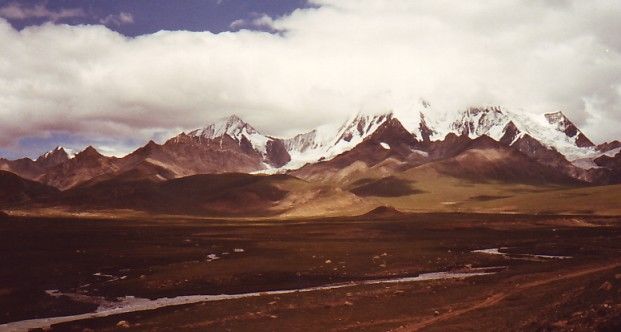
Guru Rinpoche Perfected Mahamudra & Sojourned North
Buddha Amitayus, the Buddha of Long Life, appeared to Guru Rinpoche and crowned him with 108 transmissions of practices and teachings to attain the vajra body beyond birth and death. In visions and dreams, Guru Rinpoche visited the Pure Realms of all Englightened Beings, received further instructions that lead to liberation, and continued his journey to the land that is today known as Nepal. He stayed in the cave called Yangleshö and perfected his pratice of Pälchen Yamdak, one of the eight meditation deities he had received from his Indian teacher Shri Hungkara. Thus he spontaneously attained the complete and perfect realization of Mahamudra. Students can visit this cave that is situated near Kathmandu and experience it as a symbol of Guru Rinpoche's attainment of mind's clear nature, Mahamudra.
During the time that Guru Rinpoche was meditating in Yanglesho Cave, powerful and envious local spirits created many obstacles for him. They also brought on negative circumstances and conditions, e.g., draughts, diseases, and famine in the land. Guru Rinpoche had great compassion for the people in Nepal and thought it would be best to put an end to their suffering by engaging in the practice of Vajrakilaya that he had received from Shri Hungkara and had perfected. He gave two disciples who had accompanied him all the offerings he had received from students - gold, silver, jewels, and costly substances - and a letter describing the situation to give to Shri Hungkara in India, requesting from him the texts of the "Vajrakilaya Tantra." Shri Hungkara chose the most famous one, the "Vajra Kilabitutara Tantra," the one that has been lost. He had it wrapped in silk cloth and brought from India to Nepal in a very ceremonial procession. It is said that most negative conditions that had prevailed in the area for three years ended the moment the messengers who were bringing the sacred text to Guru Rinpoche crossed the river that marked the border between India and Nepal. Yet, there were still a few rather stubborn and hard-hearted spirits who continued causing trouble in the land and, in particular, tried to obstruct devotees who tried to practice the Dharma. So, Guru Rinpoche went into the cave called Asura, situated a little bit above Yanglesho. It, too, is easily accessible and remains a favourite pilgrimage site for Buddhists from around the world.
While staying in Asura Cave, Guru Rinpoche meditated the Vajrakila text that had just been brought to Nepal. Three scornful female spirits did magic tricks to distract and disturb his meditation. Their names were Rimate, Rimata, and Rimazo and are known as `the three sisters of Rimache'; they killed and scalped human beings, ate their flesh, used their skin as clothing, etc. But due to his realization, he vanquished them by using his magical power, something nobody else could do. They were defeated in a mighty battle and requested to become his disciples and serve him. He bound them under oath to stop their negative actions right away and to serve the Dharma by becoming protectors. Ever since then, these three female goddesses are a part of the outer mandala of Vajrakilaya and are addressed as protectors in a short ritual of the complex practice.
Many followers approached Guru Rinpoche while he was practicing in Nepal, among them two Nepalese women who would become his heart-disciples. Their names were Shakya Devi and Kalasiddhi. They offered to serve him in return for empowerments and Dharma teachings. He granted them this and sent them to practice in various places in the country. They did as told and attained realization of Mahamudra very fast.
Not leaving his retreat, Guru Rinpoche saw that at the Vajrasana, `the seat of Lord Buddha's enlightenment' at Bodhgaya, 500 tirthikas, `heretic scholars,' were harassing and pressing Buddhist monks and nuns through arguments and magical demonstrations to leave the sacred area. It was the custom during those times to convert non-believers by trying to defeat them in scholarly debates. If a scholar chosen to represent one school did not convert to the other belief system after having lost, he or she had to leave the country. Guru Rinpoche saw that the Buddhists were about to lose this debate and knew that as a result the larger number of less educated people would follow the tirthikas. Staying in retreat, he sent an emanation that clearly and definitely vanquished the tirthikas. Not happy about having lost, they tried to win by resorting to magic. In that moment, Guru Rinpoche emanated a forceful form that came to be called Senge-ge-Dradrok, `Lion's Roar.' The many bursted rocks and boulders in and around Bodhgaya bear testimony to the magical force of the battle that he and the tirthikas fought. Of course, Guru Rinpoche won and therefore Bodhgaya has remained the center of Buddhism to this day.
Every time wondrous demonstrations like this took place, Guru Rinpoche was victorious. He didn't force opponents to convert to Buddhism or to leave the country, rather he clearly showed the foremost rivalling scholars and academics of other philosophical schools that the Dharma of the Buddha is the only way that leads to perfect enlightenment within the span of a single life - if one practices. Thus they won trust and confidence in the Dharma and took up the practice with joyful enthusiasm. As said, Guru Rinpoche manifested in different forms when he displayed his magical abilities on many occasions for the welfare of sentient beings. His eight or twelve names refer to those events. Let us now look at the Tibetan landscape before Guru Rinpoche arrived.
King Trisong Detsen, ruler of Tibet, was the emanation of an Enlightened Being and only had one wish, to establish the sacred Dharma teachings in his kingdom. He had contemplated the philosophies as they were known and realized that the teachings of the Buddha were the most appropriate to dispel the darkness of ignorance that caused his subjects to suffer. He asked his ministers to find the most compassionate Bodhisattva living in India. They learned that the greatest living Bodhisattva was Pandita Shantarakshita, Pandita being the Sanskrit title for Khenpo in Tibetan. He happened to be in Nepal at that time, so he was able to accept the king's invitation to come to Tibet.
Khenpo Shantarakshita was the reincarnation of a highly realized master. Before going to Tibet, he spent much time studying the Dharma in India and China. It wasn't the custom for Indian masters to travel north of the Himalaya Mountain Range because the climate was too harsh for them and the people and tribes living there had the reputation of being rough. Since his Indian and Chinese teachers had predicted that his calling was to bring the Dharma north, specifically to Tibet, Khenpo Shantarakshita, known as Khenpo Bodhisattva, accepted King Trisong Detsen's invitation, went to Tibet after having completed his obligations in Nepal, and immediately started teaching the Dharma to the king, his family, his ministers and advisors, and to representatives of the people. Both the king and Khenpo Shantarakshita saw that their karma was a deep continuation of a long-standing, strong connection. The king asked Khenpo Bodhisattva, "Can you say something about our karmic relationship?" Khenpo replied, "Yes, during the time of the Third Buddha of this eon, Buddha Kasyapa, I sold poultry at a market in Nepal and had three sons who each had different fathers. Before dying, I wanted to do something very meritorious and decided to build a Stupa. I received permission from the king and with the help of my sons and a few villagers erected the most magnificent Stupa ever built in the world at Boudhanath." The three sons were reborn centuries later and would establish the Dharma in Tibet. King Trisong Detsen, Khenpo Shantarakshita, and Guru Rinpoche were the reincarnations of these three sons.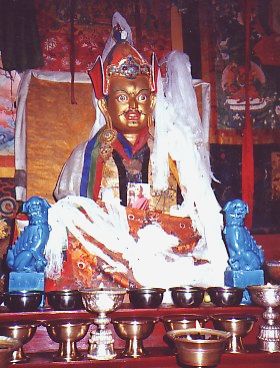
Building Samye Monastery
While Khenpo Shantarakshita was teaching Buddhism in Tibet, King Trisong Detson's strongest wish was to have the first Buddhist monastery built in his land. He asked Khenpo Shantarakshita to construct the monastery while he was promoting Buddhism. Khenpo started building the monastery at Samye, but the building collapsed after they reached a certain stage. Khenpo told the king, "I am famous throughout India and Nepal for having much compassion and can therefore lead many beings to liberation. But I don't have magical abilities to deal with the malicious spirits and demons living in your land that are obstructing this project. You should invite the master who can overcome these evil forces, and nobody is more able to do this than Guru Rinpoche." The king agreed and sent envoys to find and invite Guru Rinpoche to help build the monastery at Samye and spread the Dharma in his kingdom.
Next to the malicioius spirits and demons that obstructed the construction work on the foundation for the first Buddhist monastery in Tibet by bringing on earthquakes, floods, and storms, many ministers in the cabinet of the king who strongly rejected Buddhism also caused problems. There were many shamans and followers of the indigenous tradition among the ministers who did everything in their might to stop Buddhism from being established in Tibet. They schemed and lied about Khenpo Shantarakshita and the Buddhist masters who accompanied him, spreading rumors like, "Those Indian people wearing red hats are trying to bring the Dharma to Tibet and only cause trouble. Just look at what is happening all over the land ever since they have been trying to build a monastery here." Even though evil spirits tore many buildings down the night they were erected, nevertheless the foundation was laid and Khenpo Shantarakshita was able to consecrate the first buildings of Samye Gompa.
It wasn't possible to quell all the difficulties, though, and King Trisong Detsen knew that if he failed, it would take a very long time for anyone to even be able to attempt to establish Buddhism in Tibet. Therefore Khenpo Shantarakshita told him, "Now is the time to invite Lotus-born Padmasambhava. We have been connected for many lifetimes. There is a prophecy that states that when we three work together with the pure motivation and skilful means, then we will be able to easily establish the Dharma in the northern Land of Snow."
During all those troubles, Guru Rinpoche was meditating in Asura Cave near Parping in Nepal. Because he had profound realizations, he knew what was going on and set out to Tibet before the king's envoys reached him. He met them slightly north of the Tibetan border. They were a bit perplexed and asked him many questions to make sure they weren't mistaken about having met him in their country and not having to continue on to Nepal in search of him. They were quite astounded to learn the truth, gave him all the presents that the king had given them for him, and asked him to accompany them to the palace of the king. Demonic forces tried to block their way, but of course Guru Rinpoche vanquished them. The demons and evil spirits converted of their own accord and he bound them under oath to become Dharma protectors. Then the group continued their journey.
Shortly before Guru Rinpoche arrived in the palace, King Trisong Detsen had a dream. He dreamed that the sun and moon simultaneously rose on the horizon and that every corner of the dark land became illuminated. He interpreted his dream to mean that everything would work out fine.
One can read the various stories about Guru Rinpoche's encounters while he was on the way to Tibet. The time at our disposal during this seminar is too short to speak about all of them. I do want to say that many things happened - he flew through the sky and appeared in forceful forms to frighten the evil spirits and demons and to vanquish and transform them into Dharma protectors. His footprints and handprints, just like those of later Mahasiddhas, are still clearly visible on many rocks and bolders today, so it is possible to receive their blessings by seeing them.
When Guru Rinpoche arrived at the palace, King Trisong Detsen was over-joyous. He prostrated and gave him many offerings. When the king gave him gold-dust, which was the currency of those times and the customary offering for great masters, Guru Rinpoche flung it away and told the king, "I don't need your gold. The whole world is like gold for me." In that moment he touched a rock that was lying on the ground with his big toe and the king and all people who were present experienced that the entire area seemed to turn into gold.
By appearing in different forms, Guru Rinpoche first tested whether the Tibetans were ready to receive and practice the Dharma. He was very pleased that the king and his courtiers weren't disturbed that he wasn't in need of their presents. He tested them in more ways, saw that it was time to establish and spread the Dharma in Tibet, and began his activities. Again and again evil spirits living in specific areas tried to obstruct Guru Rinpoche from teaching. There are many testimonies left in boulders and rocks of him defeating and binding them under oath to protect the Dharma, such as boulder formations or handprints and footprints he left in rocks. It is said that mountains were moved and the course of rivers where shifted when through his magical skills he fought demons who tried to kill him. Many of these places have again become favourite pilgrimage sites for Tibetans and foreigners. The blessings one receives and the inspiration one experiences to intensify one's practice by visiting these sacred sites are immense. The obstructive demonic forces weren't only tamed and converted to work for the welfare of all living beings, but those ministers who still had doubts saw for themselves the efficacy of the teachings and became Guru Rinpoche's close disciples, received transmissions, meditated the instructions, and attained realizations.
Let me say a little bit more about what took place when Guru Rinpoche and King Trisong Detsen met for the first time. The king went out to welcome him. It was the custom to bow to a great king when one met, but Guru Rinpoche saw that he himself was the mightier king and knew that the arrogant king expected him to bow. But Guru Rinpoche waited for the king to bow to him. Both men stood still and nobody budged. The king, who was extremely proud, was rather perplexed that the great master did not bow to him. Guru Rinpoche let the king feel that he was the ornament of the world. After all, the king had asked him to come and do what nobody had done before, to establish the Dharma in Tibet. While the king became more bloated with pride, Guru Rinpoche made a small hand gesture and everybody who was there saw that flames spurted out of his finger and engulfed the king, even burning him a little bit. Everybody, including the king, was shocked. He realized how proud and arrogant he had been, fell on his knees, confessed his negative thoughts, and prostrated to the Second Buddha of this eon. As of then, Guru Rinpoche was respected as the greatest master and could start teaching and spreading the Dharma in the Land of Snow. The king requested to become a disciple and to serve him from then on. Guru Rinpoche accepted, so the king became the first of his many disciples in the north.
Having vanquished and tamed many demons that impeded the introduction of Buddhism to Tibet, Guru Rinpoche was able to start his work on Samye Monastery. With his magical abilities, he subdued the earth spirits, particularly the Nagas in the area, and moved them to promise never to cause harm again. With the assistance of Khenpo Shantarakshita, he performed the ritual consecration of the foundation of the monastic complex. Having committed the spirits to be helpers, they worked on the construction of the buildings during the night instead of destroying the work that was accomplished by humans during the day. And so, construction work on Samye Monastery resumed day and night. The entire complex consisted of 17 temples and many other buildings and was completed in 13 years. The complex was built in the form of a Mandala, i.e., the world-system according to ancient Indian cosmology. The central and largest temple was built in the form of Mt. Meru, two temples were built in resemblance of the sun and moon that circle Mt. Meru, four temples were built to represent the four main continents, and eight further temples symbolized the eight subcontinents. Furthermore, many smaller ritual buildings were erected inside the complex. The top of the temples consisted of three roofs, designed in the Indian, Chinese, and Tibetan styles, representing the three main lands where the Dharma was established. The entire complex was surrounded by a gigantic wall lined with magnificent Stupas.
When Samye Monastery was completed, Guru Rinpoche and the masters who helped build the monastery performed the great inauguration ceremony. It was a momentous day. Not only many people attended the ceremony, but Dakas, Dakinis, and deities appeared in the sky and strew flowers, recited blessing prayers, sang songs of joy, and so forth. It was a day of great rejoicing and fulfillment.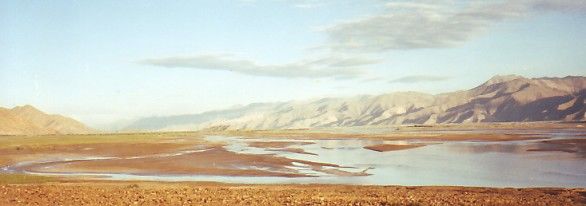
Lighting the Lamp of Dharma in Tibet
The Dharma spread in Tibet in phases. The phase in which King Trisong Detsen wished to establish Buddhism in his kingdom is seen as the dawning of Buddhism in Tibet, in that the first rays of light slowly started dispelling the darkness of ignorance in the minds of people living there. The period in which Guru Rinpoche and Khenpo Shantarakshita taught the Dharma and inaugurated Samye Monastery is referred to as the blossoming of Dharma in the Land of Snow.
The greater number of Tibetans didn't know about the Dharma. Since Samye Monastery was completed, the king feared that Guru Rinpoche and Khenpo Shantarakshita would return to India. He gave them beautiful offerings and again and again asked them to stay and to teach every aspect of the Dharma to all the people in the land. They agreed. It is recorded that Khenpo Shantarakshita intended to return to India after a while, but he stayed and taught in Tibet until the end of his life. Actually, the main part of their work was yet to start. Since Dharma texts were not available in the Tibetan language, they had to educate a number of translators who first needed to learn the different Indian languages.
Guru Rinpoche and Khenpo Shantarakshita requested that the king call together the most intelligent children in the land so that they could be educated as translators at Samye Monastery. Many children came and Khenpo Shantarakshita examined which ones were most capable of learning the languages of India. He tested them by speaking easy Indian words and asked the youngsters to repeat them. Everything went wrong. No one was able to even repeat one or two words correctly. Different tests were carried out, but capable children weren't found. Khenpo was so frustrated that he wondered, "How can we teach these barbarians the languages of India?" Guru Rinpoche and Khenpo discussed the matter and Guru Rinpoche remarked, "There's no reason to despair. Buddha Shakyamuni's three main disciples, Ananda, Maudgalputra, and Shariputra have been reborn. They will be the first translators who in turn will educate more translators." With his wisdom eye, Guru Rinpoche saw that they had been born as sons of local chieftains. He and Khenpo went to each family, told the respective parents who their son was, and asked for permission to take the boy with them so that he could be educated for the sake of the Dharma in the Himalayas. All three families had deep respect for the Dharma and consented.
The boys were first sent to study with leading scholars in India to learn the various languages spoken there, seeing the Dharma texts weren't only written in one language. They also had to practice and realize the instructions of those texts. They spent 13 years in India and studied with the same masters who had taught Guru Rinpoche and Khenpo Shantarakshita. The young men had made a name for themselves by the time they returned to Tibet and would become the first three of 108 great translators. They were the unequalled masters Berotsana, Kawa Paltsek, and Chokro Lui Gyältsen. They had learned the languages of India, knew the meaning of the profound texts, started translating them into Tibetan, and educated other translators. It was an enormous task to translate the vast collection of Dharma texts into the Tibetan language and required the help of assistants that the three great translators had educated. The assistants were later able to translate texts on their own.
The first major work that was translated with immense accuracy was all Buddhist religious works of India that were compiled in the "Kangyur - The Translation of Lord Buddha's Words." The "Kangyur" is a collection of Sanskrit classics that trace their origin to the spoken word of Buddha Shakyamuni and consists of over 1000 books in about 100 volumes of woodblock prints. The "Tengyur - The Translations of Teachings" was then translated. It is a collection of approximately 3,500 books written mostly in Sanskrit, texts that explain the books of the "Kangyur" and other subjects such as literature, linguistics, science, architecture, painting, and medicine. This was the primary work that was started under the direction of Berotsana and completed by other masters.
Of course, problems and obstacles arose, because translators not only had to know the languages they were translating fluently but also had to have understood and attained some experiences of the meditation practices they were translating. It was a very challenging task that didn't consist of book-learning only but presupposed consistent own practice. For instance, another problem was that Berotsana, who was a fully-ordained monk, was extremely handsome, so many queens did everything they could to attract his attention, which made it hard for him to concentrate on his work. The disappointed queens created intrigues against Berotsana, who was innocent of their accusations. Those who had intrigued against Berotsana forced the king to ban him. It was the custom to ask where a person chose to go when this sentence was decreed. Guru Rinpoche and King Trisong Detsen asked Berotsana. Being a realized master, he knew that he would meet students with whom he had a karmic connection with from India and who were open enough for the Dharma so that he could teach them to translate. Therefore he chose to be banned to Tsawarong in East Tibet. He was able to continue translating undisturbed and was very productive.
A number of Guru Rinpoche's disciples also made a connection with him. One of his 25 disciples was a young princess who had been promised to the king. She was known as Princess of Karchen and would become famous as Guru Rinpoche's most important consort. Her name was Yeshe Tsogyäl. She, too, became famous for her translation work. She is best known for having helped conceal sacred texts that Guru Rinpoche had reserved for the benefit of future generations. They were revealed hundreds of years later by his reincarnated disciples who disseminated them when times were right.
While work was progressing in the Kingdom of Central Tibet, Berotsana was training disciples to become translators and met his heart-disciple, the reason he had chosen to be in Tsawarong. He was the son of a chieftain in East Tibet who had lost his wealth through gambling and was already a young man when he and Berotsana met. Having experienced the futility of his family's lifestyle, the young man had already generated revulsion for samsara. The great translator recognized that they had a strong connection from past lives and accepted him as his disciple. His name was Yudra Nyingpo. He studied intensively, practiced diligently, attained realization very fast, and accompanied Berotsana to Central Tibet when he was allowed to return. They arrived at Samye Monastery when the first translations of the "Kangyur" and "Tengyur" were presented to the king in the presence of Guru Rinpoche and Khenpo Shantarakshita.
Mahapandita Vimalamitra, the great translator from Kashmir, was in Tibet at that time and, just as Guru Rinpoche and Khenpo Shantarakshita, he was central in disseminating the Dharma in the Land of Snow. Vimalamitra met Yudra Nyingpo and asked him, "Who are you and where do you come from?" The young man answered, "My name is Yudra Nyingpo and I come from the the district called Tsawarong." Vimalamitra asked him, "Who is your teacher?" He replied, "My teacher is the translator Berotsana. Do you know him?" Vimalamitra said, "Of course I know him. He is one of my most important disciples." So, the deep bond between Vimalamitra and Yudra Nyingpo was established and it would be very, very fruitful. Vimalamitra had many disciples. He had brought an entire body of sacred texts to Tibet and was responsible for the translation of specific teachings into the Tibetan language. It isn't known how long he stayed in Tibet. It is recorded that Vimalamitra stayed in Tsawarong for a while, imparted teachings and empowerments to students who came to him there, and continued his journey to China. As of then, nothing more is known about him.
Guru Rinpoche stayed in Tibet for many years. One biography tells us that he stayed for 300 years and that he never grew tired of spreading the Dharma and teaching students the path to realization. One of Guru Rinpoche's most important contributions for future generations of Dharma practitioners was concealing a large number of treasure scriptures and teachings. He saw that it was too early to present them to anyone but his heart-disciples, which he did. Then he buried or hid them in a great variety of forms in the entire land of the Himalayas. He knew that they would be revealed when followers were ready to receive them. This was the beginning of what is known in the Nyingma Tradition as the Terma Tradition, gter-ma meaning `treasure' in Tibetan. Masters having the title gter-stön, `revealers of concealed treasure teachings,' in their name were Guru Rinpoche's heart-disciples who had received the transmission from him personally and reincarnated hundreds of years later. When they found and revealed the sacred teachings, they were guaranteeing the well-being of countless living beings.
We see that Guru Rinpoche was very, very compassionate and is revered by Tibetans and followers world-wide as the most important teacher of Buddhism who appeared on the Tibetan Plateau. One can read about his many other activities in biographies that have been translated into Western languages.
Guru Rinpoche Sojourned Southwest & Manifested His Pure Land
A very barbarious tribe of beings populated an island known as Kumara that was situated in the southwestern ocean. They threatened to destroy everything that was wholesome and good in the world. Guru Rinpoche saw that he had to go to Kumara Island and stop them. He went, vanquished the evil spirits, and brought them to seek refuge in Lord Buddha's teachings.
Then Guru Rinpoche manifested his Pure Realm to his faithful disciples and ever since then continues residing in the Pure Land that is known in Tibetan as Zangs-mdog-dpäl-ri, `Glorious, Copper-Coloured Mountain.'
The Unbroken Lineage
The sacred teachings taught and concealed by Guru Rinpoche and Yeshe Tsogyäl continued and continue to be present to this day in the Lineage of tertöns, `treasure revealers,' who find, bring to light, practice, and spread them at the right time and in an appropriate manner and place. The name of each tertön is listed in an autobiography of Guru Rinpoche. In the course of history, 108 tertöns have appeared and every one had received the transmission of the cycle of teachings they revealed from him personally. Furthermore, the tertöns were and are able to recognize and translate the symbolic language and signs of the original into modern Tibetan so that they can be understood by devoted practitioners and can help them progress spiritually.
In this way, Guru Rinpoche was exceptionally compassionate, generous, and kind. He didn't shy away from any hardships to work for the benefit of the people of Tibet by teaching and establishing the Dharma in the Land of Snow. He also cared for future generations worldwide by hiding and burying sacred teachings that have been found and revealed and that will continue being brought to light when followers are ready and ripe to benefit from them whole-heartedly.
Conclusion
This has been a short introduction to the very eventful life of Guru Rinpoche. Unfortunately, this seminar is coming to an end, so we cannot go into more detail. There are many volumes of biographies that each consists of hundreds of pages that you can read. With the time at our disposal now, I will gladly try to answer any questions that you might have.
Questions & Answers
Question: "Where will the 108 tertöns appear now?"
Lama Namse: It's hard to say, because there are so many charlatains around nowadays. This was the case in Tibet, too. Many people pretended to be tertöns and led people astray. Authentic tertöns reveal themselves unmistakably and are recognized by great masters. Guru Rinpoche's 108 tertöns appeared and can take on new rebirths in order to reveal termas that are still hidden. Just as in the past, it's important to be very careful and critical, because there are always many charlatains in this category of incarnations. One needs to check if someone is authentic or not.
Next question: "When King Trisong Detsen and Guru Rinpoche met, both expected the other to bow to him. It sounds like it was a kind of power-play. Guru Rinpoche was free of attachment, so why didn't he honour the king? What was the purpose of waiting for the king to bow to him?"
Lama Namse: Since we were not there, we have to rely on interpretations. It is said that Guru Rinpoche was invited and came to Tibet as a fully enlightened master to bring the Dharma, which is the most precious treasure ever brought to the Land of Snow. Therefore, he was much higher than the king and did not feel necessitated to bow to him. He didn't expect the king to bow to him, but it was clear that he wouldn't bow to the king. Furthermore, when they met, Guru Rinpoche saw that a sense of pride arose in the king, which needed to be dispelled. The king bowed to the entirety of the teachings that Guru Rinpoche was bringing to Tibet when he bowed to him. Guru Rinpoche represented the teachings, so bowing to him symbolized that the teachings of the Buddha had arrived in Tibet. The teachings are so precious that its representative doesn't bow to anything lower. One can see it this way. Of course, Guru Rinpoche was free of self-centered thoughts and the fact that the king bowed meant nothing to him.
Next question: "Demons and evil spirits helped build Samye Monastery, which is why it was completed faster. Is this meant concretely or is this said so that the negative, self-centered attitude of the workers is reversed and is positive?"
Lama Namse: It can be interpreted in different ways. Westerners don't have the same ideas of ghosts and demons. Ghosts and spirits have a realistic presence for Tibetans, so one can interpret it to mean to purify people's self-centered ideas. It's a valid interpretation. -- Thank you very much.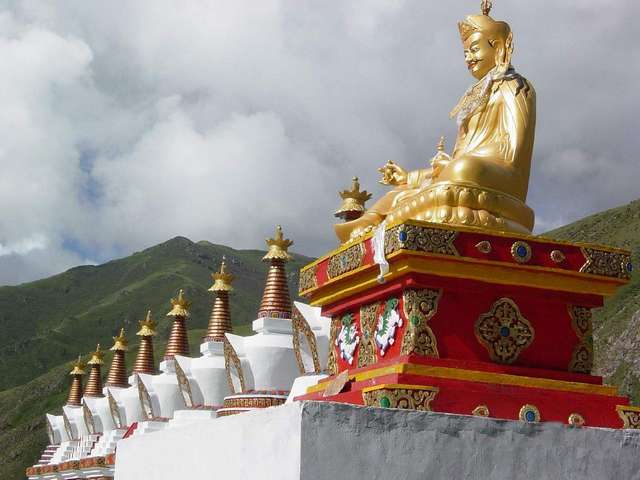
(Guru Rinpoche & Stupas at Lodrö Nyima Rinpoche's Gompa in Qinghai)
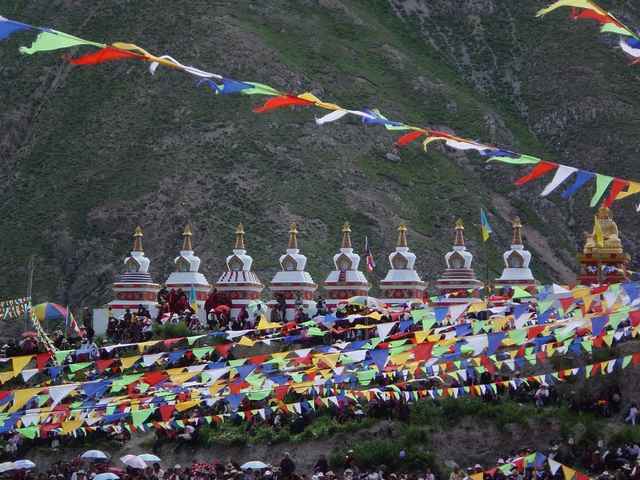
"Anyone with faith in me is a fit vessel for my blessings. They are never apart from me.
I am here. I haven't gone anywhere."
-- from "Treasure Biographies of Padmakara and Vairochana"
Dedication Prayers
Through this goodness, may omniscience be attained
And thereby may every enemy (mental defilement) be overcome.
May beings be liberated from the ocean of samsara
That is troubled by waves of birth, old age, sickness, and death.
May bodhichitta, great and precious,
Arise where it has not arisen,
Never weakening where it has arisen.
May it grow ever more and more.
Long Life Prayer for the Dharma Lord Lama Namse,
entitled "Deathless Moon Nectar"
You who took birth in the invincible vajra net of the Three Secrets,
In a mudra dance of the Four Indestructible Vajras,
May your glorious life, like a nectar rain of stable understanding
Be embraced by the anthers in White Tara's heart.
While you place all beings, in their many forms, on the wholesome path of liberation,
The glory of your excellent signs blaze in the midst of millions of Bodhisattvas.
May you let the deep melodious sound of Dharma, the blissful union of the Two Truths
Resound in the nectar residence of the ear of those wishing liberaton.
Through the power of the truth of the Three Roots, the deities, and the whole gathering of yidam deities
May the glorious Lama's lotus feet remain stable for hundreds of kalpas.
May your amazingly wholesome activity flow like a river in a sandalwood tree forest.
May your noble and learned good qualities spread as far as the sky.
His Holiness the XVIIth Gyalwa Karmapa, Ogyen Trinley Dorje, prayed like this at the request of Khen Loyak. May it be virtuous!
Long Life Prayer for His Eminence the IVth Jamgon Kongtrul Rinpoche,
Lodrö Chökyi Nyima
May the life of the Glorious Lama remain steadfast and firm.
May peace and happiness fully arise for beings as limitless in number as space is vast in extent.
Having accumulated merit and purified negativities,
May I and all living beings without exception swiftly establish the levels and grounds of Buddhahood.
Sincere gratitude to Thomas Roth for his excellent simultaneous translation of Tibetan into German during the seminar. Translated into English from the German rendering, edited & arranged by Gaby Hollmann, responsible for all mistakes. Photos of Guru Rinpoche on the shrine, of Tingri & of the Tsangpo River near Samye Monastery taken by gh in 1986. Invaluable photos of Guru Rinpoche's cave in Sikkim, of Stupas at Tashiding Monastery in Sikkim, of the statue of Guru Rinpoche & Stupas at Lodrö Nyima Rinpoche's Gompa in Qinghai taken & graciously offered for this article by Lena Fong. Sincere gratitude to Hans Billing for having made the recording of the seminar available to us & for managing the website of Karma Chang Chub Choephel Ling with upright sincerity. Simply saying "thank you" to Lama Dorothea Nett & everyone who contributed meaningfully for this article does not suffice. Copyright Chöje Lama Namse Rinpoche, Karma Chang Chub Choephel Ling in Heidelberg & Karma Lekshey Ling in Nepal, 2009. All rights reserved.



